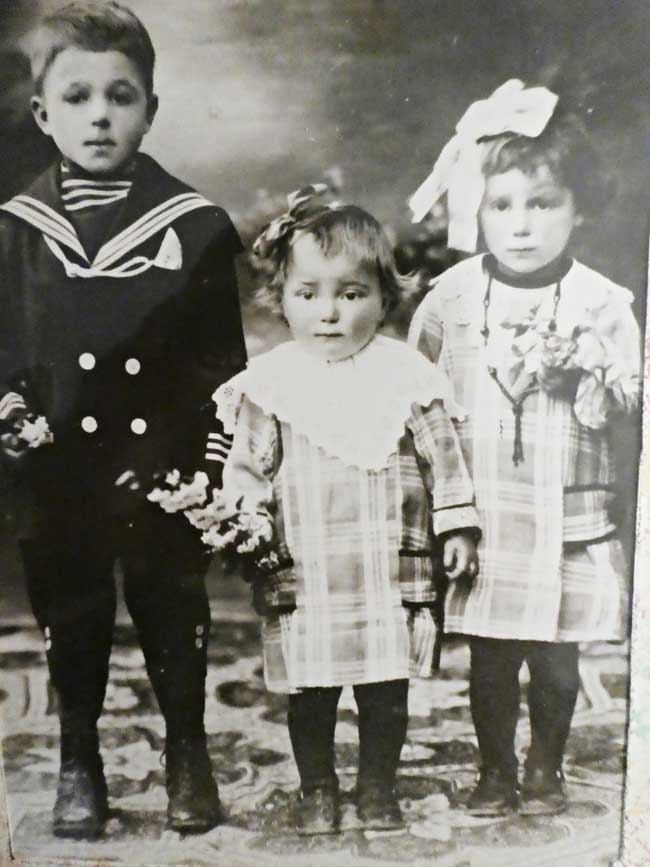by Eileen Pedersen, Trail BC

Two of my uncles died during WWI in Northeast Italy—one, my mom’s brother Vincenzo, a Red Cross soldier; and the other, my dad’s brother Attilio, a soldier who succumbed to The Great Influenza of 1918. Conditions during the war were deplorable in so many ways as the battles mostly took place during the winters in the precipitous Dolomite mountains along the Isonzo River (“Isonzo~~The Forgotten Sacrifice of The Great War”, 2001, by John R. Schindler). Forgotten, because largely, little has been recorded of these battles, contributing to a collective amnesia of Italy’s involvement, and, there has been a perception that Italians were incompetent fighters. I grew up with this joke: “What did the Germans do with the grenade the Italians threw at them? They lit it and threw it back”. For me, that was my family’s country’s legacy until I began to delve into my family’s her/history.

After the Italians suffered a resounding defeat by the Austro-German forces at the Sept.-Oct. 1917 Battle of Caporetto on the NE Italian front, my grandfather sent my grandmother, their five daughters, and youngest son, 9, to Genoa as refugees. At least 250 000 women and young boys from the Friul and Veneto areas also left for various parts of Italy. My parents and several previous generations were peasant farmers on the plains of the Friul of Northern Italy in the village of San Martino al Tagliamento. The “Tagliamento” is one of the most important “braided” rivers in the world, meaning, it runs mostly underground, except during spring runoff from the Dolomites, or when rainstorms occur. The town is one hour and a half northeast of Venice.
My family stayed at the “Albergo Dei Poveri” (Hotel for the Poor) in Genoa for 18 months. My mother was 10. My grandfather stayed home to tend to and protect the farm animals and the land they owned. The eldest son, my uncle Vincenzo, though he was with the Red Cross during the war and was apparently protected, was killed in 1916. He is buried in Gorizia. I heard the story of how the family found out about his death several times over the years: his sister Rosina, about 12 at the time, woke up from a dream screaming ‘Vincenzo is dead! Vincenzo is dead!’ Oh don’t be silly, the family reassured her, as they’d just received a letter from him. However word was out that men from the village had been killed. My grandmother went out into the street to find out who. “Yours for sure” one of the village women told her point blank. There are several stories of dreams such as this one in our family.
My mother’s oldest sister Annuta, married in 1915 and pregnant with her second child, also accompanied the family to Genoa with her 18 month old son Vincenzo. The day she birthed her second at L’Albergo Dei Poveri, Vincenzo died of meningitis—May 31, 2018.
Approximately a year later it was safe for the family to return home. Annuta gave birth to two more children, both girls. Tragically, she died the day her youngest daughter was born, Feb. 6, 1921.
With the rise of Benito Mussolini’s Fascist Party, directives were issued to collect gold wedding rings from the poor and exchange them for metal bands. Italians were strongly encouraged to comply for fear of reprisal. Annuta’s husband, Leonardo, “donated” his wife’s wedding ring when he was paid a visit by party members at his home. It was replaced with a metal one. After my mother and father married in 1934 and after my father returned to Canada in 1935, Leonardo brought his deceased wife’s metal wedding band to my mother. He told her to hide her gold ring and to wear the metal one, which she did. When party members came calling, she had no gold to contribute.
About 3 years ago, my eldest sister Anita, entrusted with its care, passed it on to me, along with the story. She knew of my quest to research and record family her/history and thought I should have it. I am so grateful for that kind gesture.
Eileen Truant Pedersen is an adult educator, writer, and retired school teacher who loves kids, music, dancing, and photography. She is the author of “Set in Stone~A History of Trail’s Rock Walls”, about the 100s of rock walls and their builders, mostly Italian stone masons. Her son and grandsons are based in the Northwest Territories. She returned to her home town of Trail BC 20 years ago.




